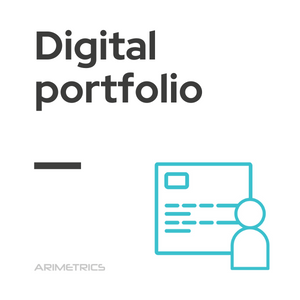
Definition:
A Digital Portfolio, also known as Electronic Portfolio or e-Portfolio, is a tool that collects the set of content, documents, works, presentations and others with the aim of presenting the best work of an individual or organization, presented in digital format.
In this way, it is presented as a grouping of digital content that works as a presentation. It is an element that is becoming enormously popular in the digital world due to its ease of being shared on the internet, both by social networks, web pages and email.
Uses of the digital portfolio
The digital portfolio has become a truly useful tool in the digital world, thanks in part to its versatility and variety of uses:
- CV: More and more companies in certain jobs ask applicants to see their digital portfolio, as a way of evaluating their abilities and as a complement to their curriculum so that a good digital portfolio can make the difference between getting a job or not.
- Business between companies:also within business it is increasingly common for companies to present their portfolios in order to obtain customers or as a letter of presentation of their products or services.
- Education: in the educational field, which is increasingly represented in the digital world, portfolios appear as a tool with a double utility; on the one hand as a learning tool that the tutor provides to the student, on the other hand as a measure of evaluation that contains the work of a student and that in some cases is coming to replace the exams.
How to create a digital portfolio
When creating an e-Portfolio, we must follow a series of steps and recommendations:
- Be selective:the objective of a digital portfolio is not to accumulate as much content as possible, but that it represents the best of our work so it is better quality than quantity.
- Adapt it to the recipient: for the portfolio to have the best effect, it must always be designed with the target audience in mind: what they are looking for and how we can create a good image for them.
- Include contact information: it will be useless to have made a good impression with our portfolio if they have no way of finding us, especially in the digital environment where information spreads much faster, so we should always include our phone number, email, social networks and other relevant information.
Platforms to create a digital portfolio
There are several platforms that facilitate the creation of digital portfolios, each with features that suit different needs and styles. Below are some of the most popular platforms for designing a digital portfolio:
- Behance: Ideal for creatives and designers, Behance allows you to share projects and receive feedback from the community. It is an excellent option to showcase visual work and connect with other professionals in the industry.
- Wix: Wix offers an easy-to-use website builder with a variety of customizable templates. It is suitable for those looking to create a visually appealing portfolio without advanced technical knowledge.
- Squarespace: With a focus on elegant and professional design, Squarespace is ideal for artists, photographers and designers who want to present their work in a sophisticated way. It offers integrated e-commerce and customization tools.
- WordPress: With its flexibility and wide range of plugins, WordPress is a robust option for creating custom digital portfolios. It is suitable for users who want full control over the design and functionality of their site.
- Adobe Portfolio: Part of the Adobe suite, this platform allows Creative Cloud users to create custom portfolios that easily integrate their work from Photoshop, Illustrator and other Adobe applications.
